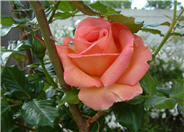
Common name:Munstead Dwarf Lavender
Botanical name:Lavandula angustifolia 'Munstead'
While this hybrid is half the size of the standard angustifolia, it flowers early and has a more intense flower color than most of the species. Its foliage and flowers are good for sachets. This is a perfect choice for smaller scale situations. It is drought tolerant and attracts butterflies and hummingbirds.
-Cornflower Farms

Common name:Baja Dudleya
Botanical name:Dudleya brittonii
Dudleya brittonii is a succulent with a large open rosette of glaucous leaves. This plant will grow 15" high and produces pale yellow flowers on 35" stems.

Common name:Grosso Long Stemmed Lavender
Botanical name:Lavandula X intermedia 'Grosso'
Long Stemmed Lavender has beautiful violet colored plumes in the summer. Very drought tolerant and it is a great plant to create that Mediterranean effect.

Common name:European Grapevine
Botanical name:Vitis vinifera
Grows 20-30' vining branches. Many named cultivar varieties of eating and wine-grapes.

Common name:Hybrid Tea Rose (selections)
Botanical name:Rosa Hybrid Tea varieties
These shrubs and vines are the most-loved in the West and are very resilient. They come in a wide variety of sizes and colors and are easy to maintain with proper care. They can be used in a water-conserving garden with careful attention to irrigation practices.
| Designer: Tom Deyerlee Landscape Arch. | Beginning of the Stairs |
Photographer: GardenSoft |
Soils and Compost:
Maintain a two to four inch layer of mulch on the soil surface to reduce weeds, infiltrate rain water, and reduce compaction.
Water Saving Tip:
Apply a 2-3 inch layer of mulch in planting beds to conserve water, suppress weeds, and protect the soil from compaction and erosion.
Integrated Pest Management:
Remove irrigation water and fertilizer from areas where you don't want weeds to grow.
